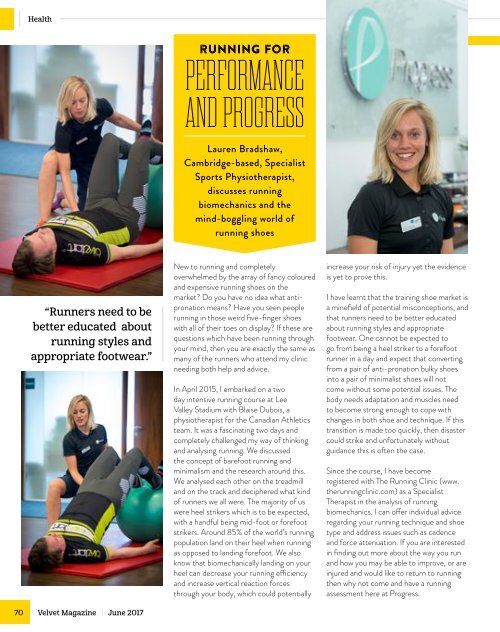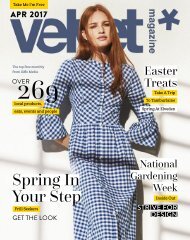You also want an ePaper? Increase the reach of your titles
YUMPU automatically turns print PDFs into web optimized ePapers that Google loves.
Health<br />
running for<br />
PERFORMANCE<br />
AND PROGRESS<br />
Lauren Bradshaw,<br />
Cambridge-based, Specialist<br />
Sports Physiotherapist,<br />
discusses running<br />
biomechanics and the<br />
mind-boggling world of<br />
running shoes<br />
“Runners need to be<br />
better educated about<br />
running styles and<br />
appropriate footwear.”<br />
New to running and completely<br />
overwhelmed by the array of fancy coloured<br />
and expensive running shoes on the<br />
market? Do you have no idea what antipronation<br />
means? Have you seen people<br />
running in those weird five-finger shoes<br />
with all of their toes on display? If these are<br />
questions which have been running through<br />
your mind, then you are exactly the same as<br />
many of the runners who attend my clinic<br />
needing both help and advice.<br />
In April 2015, I embarked on a two<br />
day intensive running course at Lee<br />
Valley Stadium with Blaise Dubois, a<br />
physiotherapist for the Canadian Athletics<br />
team. It was a fascinating two days and<br />
completely challenged my way of thinking<br />
and analysing running. We discussed<br />
the concept of barefoot running and<br />
minimalism and the research around this.<br />
We analysed each other on the treadmill<br />
and on the track and deciphered what kind<br />
of runners we all were. The majority of us<br />
were heel strikers which is to be expected,<br />
with a handful being mid-foot or forefoot<br />
strikers. Around 85% of the world’s running<br />
population land on their heel when running<br />
as opposed to landing forefoot. We also<br />
know that biomechanically landing on your<br />
heel can decrease your running efficiency<br />
and increase vertical reaction forces<br />
through your body, which could potentially<br />
increase your risk of injury yet the evidence<br />
is yet to prove this.<br />
I have learnt that the training shoe market is<br />
a minefield of potential misconceptions, and<br />
that runners need to be better educated<br />
about running styles and appropriate<br />
footwear. One cannot be expected to<br />
go from being a heel striker to a forefoot<br />
runner in a day and expect that converting<br />
from a pair of anti-pronation bulky shoes<br />
into a pair of minimalist shoes will not<br />
come without some potential issues. The<br />
body needs adaptation and muscles need<br />
to become strong enough to cope with<br />
changes in both shoe and technique. If this<br />
transition is made too quickly, then disaster<br />
could strike and unfortunately without<br />
guidance this is often the case.<br />
Since the course, I have become<br />
registered with The Running Clinic (www.<br />
therunningclinic.com) as a Specialist<br />
Therapist in the analysis of running<br />
biomechanics. I can offer individual advice<br />
regarding your running technique and shoe<br />
type and address issues such as cadence<br />
and force attenuation. If you are interested<br />
in finding out more about the way you run<br />
and how you may be able to improve, or are<br />
injured and would like to return to running<br />
then why not come and have a running<br />
assessment here at Progress.<br />
70<br />
<strong>Velvet</strong> <strong>Magazine</strong> | <strong>June</strong> <strong>2017</strong>
















